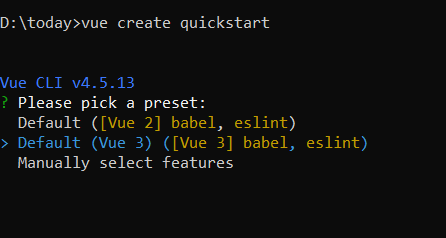Getting Started with the Vue List box Component in Vue 2
25 Apr 202510 minutes to read
This article provides a step-by-step guide for setting up a Vue 2 project using Vue-CLI and integrating the Syncfusion® Vue List box component using the Composition API / Options API.
Prerequisites
System requirements for Syncfusion® Vue UI components
Setting up the Vue 2 project
To generate a Vue 2 project using Vue-CLI, use the vue create command. Follow these steps to install Vue CLI and create a new project:
npm install -g @vue/cli
vue create quickstart
cd quickstart
npm run serveor
yarn global add @vue/cli
vue create quickstart
cd quickstart
yarn run serveWhen creating a new project, choose the option Default ([Vue 2] babel, eslint) from the menu.

Once the quickstart project is set up with default settings, proceed to add Syncfusion® components to the project.
Add Syncfusion® Vue packages
Syncfusion® packages are available at npmjs.com. To use Vue components, install the required npm package.
This article uses the Vue List box component as an example. Install the @syncfusion/ej2-vue-dropdowns package by running the following command:
npm install @syncfusion/ej2-vue-dropdowns --saveor
yarn add @syncfusion/ej2-vue-dropdownsImport Syncfusion® CSS styles
You can import themes for the Syncfusion® Vue component in various ways, such as using CSS or SASS styles from npm packages, CDN, CRG and Theme Studio. Refer to themes topic to know more about built-in themes and different ways to refer to themes in a Vue project.
In this article, the Material theme is applied using CSS styles, which are available in installed packages. The necessary Material CSS styles for the List box component and its dependents were imported into the <style> section of src/App.vue file.
<style>
@import "../node_modules/@syncfusion/ej2-base/styles/material.css";
@import "../node_modules/@syncfusion/ej2-inputs/styles/material.css";
@import "../node_modules/@syncfusion/ej2-vue-dropdowns/styles/material.css";
</style>Add Syncfusion® Vue component
Follow the below steps to add the Vue List box component using Composition API or Options API:
1. First, import and register the List box component in the script section of the src/App.vue file. If you are using the Composition API, you should add the setup attribute to the script tag to indicate that Vue will be using the Composition API.
<script setup>
import { ListBoxComponent as EjsListbox } from "@syncfusion/ej2-vue-dropdowns";
</script><script>
import { ListBoxComponent } from "@syncfusion/ej2-vue-dropdowns";
export default {
components: {
'ejs-listbox': ListBoxComponent
}
}
</script>2. In the template section, define the List box component with the dataSource property.
<template>
<div id="app">
<div id='container' style="margin:10px auto 0; width:250px;">
<ejs-listbox :dataSource='data' ></ejs-listbox>
</div>
</div>
</template>Binding data source
After initialization, populate the ListBox with data using the dataSource property. Here, an array of object is passed to the ListBox component.
<template>
<div id="app">
<div id='container' style="margin:10px auto 0; width:250px;">
<ejs-listbox :dataSource='data' ></ejs-listbox>
</div>
</div>
</template>
<script setup>
import { ListBoxComponent as EjsListbox } from "@syncfusion/ej2-vue-dropdowns";
const data = [
{ text: 'Hennessey Venom', id: 'list-01' },
{ text: 'Bugatti Chiron', id: 'list-02' },
{ text: 'Bugatti Veyron Super Sport', id: 'list-03' },
{ text: 'SSC Ultimate Aero', id: 'list-04' },
{ text: 'Koenigsegg CCR', id: 'list-05' },
{ text: 'McLaren F1', id: 'list-06' },
{ text: 'Aston Martin One- 77', id: 'list-07' },
{ text: 'Jaguar XJ220', id: 'list-08' },
{ text: 'McLaren P1', id: 'list-09' },
{ text: 'Ferrari LaFerrari', id: 'list-10' },
];
</script><template>
<div id="app">
<div id='container' style="margin:10px auto 0; width:250px;">
<ejs-listbox :dataSource='data' ></ejs-listbox>
</div>
</div>
</template>
<script>
import { ListBoxComponent } from "@syncfusion/ej2-vue-dropdowns";
export default {
components: {
'ejs-listbox': ListBoxComponent
},
data (){
return {
data: [
{ text: 'Hennessey Venom', id: 'list-01' },
{ text: 'Bugatti Chiron', id: 'list-02' },
{ text: 'Bugatti Veyron Super Sport', id: 'list-03' },
{ text: 'SSC Ultimate Aero', id: 'list-04' },
{ text: 'Koenigsegg CCR', id: 'list-05' },
{ text: 'McLaren F1', id: 'list-06' },
{ text: 'Aston Martin One- 77', id: 'list-07' },
{ text: 'Jaguar XJ220', id: 'list-08' },
{ text: 'McLaren P1', id: 'list-09' },
{ text: 'Ferrari LaFerrari', id: 'list-10' },
]
}
}
}
</script>Here is the summarized code for the above steps in the src/App.vue file:
<template>
<div id="app">
<div id='container' style="margin:10px auto 0; width:250px;">
<ejs-listbox :dataSource='data'></ejs-listbox>
</div>
</div>
</template>
<script setup>
import { ListBoxComponent as EjsListbox } from "@syncfusion/ej2-vue-dropdowns";
const data = [
{ text: 'Hennessey Venom', id: 'list-01' },
{ text: 'Bugatti Chiron', id: 'list-02' },
{ text: 'Bugatti Veyron Super Sport', id: 'list-03' },
{ text: 'SSC Ultimate Aero', id: 'list-04' },
{ text: 'Koenigsegg CCR', id: 'list-05' },
{ text: 'McLaren F1', id: 'list-06' },
{ text: 'Aston Martin One- 77', id: 'list-07' },
{ text: 'Jaguar XJ220', id: 'list-08' },
{ text: 'McLaren P1', id: 'list-09' },
{ text: 'Ferrari LaFerrari', id: 'list-10' },
];
</script>
<style>
@import "../node_modules/@syncfusion/ej2-base/styles/material.css";
@import "../node_modules/@syncfusion/ej2-inputs/styles/material.css";
@import "../node_modules/@syncfusion/ej2-vue-dropdowns/styles/material.css";
</style><template>
<div id="app">
<div id='container' style="margin:10px auto 0; width:250px;">
<ejs-listbox :dataSource='data'></ejs-listbox>
</div>
</div>
</template>
<script>
import { ListBoxComponent } from "@syncfusion/ej2-vue-dropdowns";
export default {
name: "App",
components: {
'ejs-listbox': ListBoxComponent
},
data() {
return {
data: [
{ text: 'Hennessey Venom', id: 'list-01' },
{ text: 'Bugatti Chiron', id: 'list-02' },
{ text: 'Bugatti Veyron Super Sport', id: 'list-03' },
{ text: 'SSC Ultimate Aero', id: 'list-04' },
{ text: 'Koenigsegg CCR', id: 'list-05' },
{ text: 'McLaren F1', id: 'list-06' },
{ text: 'Aston Martin One- 77', id: 'list-07' },
{ text: 'Jaguar XJ220', id: 'list-08' },
{ text: 'McLaren P1', id: 'list-09' },
{ text: 'Ferrari LaFerrari', id: 'list-10' },
]
}
}
}
</script>
<style>
@import "../node_modules/@syncfusion/ej2-base/styles/material.css";
@import "../node_modules/@syncfusion/ej2-inputs/styles/material.css";
@import "../node_modules/@syncfusion/ej2-vue-dropdowns/styles/material.css";
</style>Run the project
To run the project, use the following command:
npm run serveor
yarn run serve